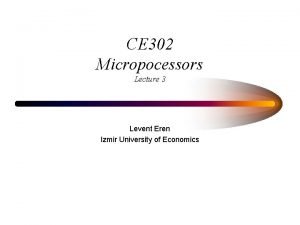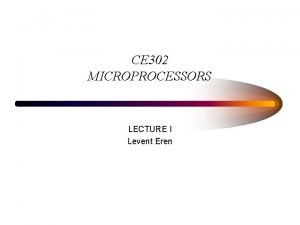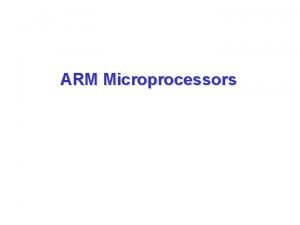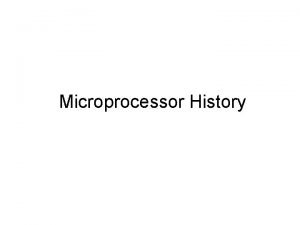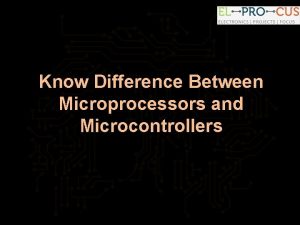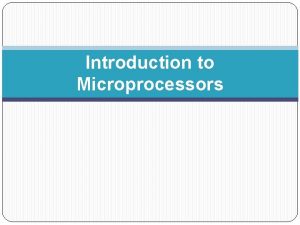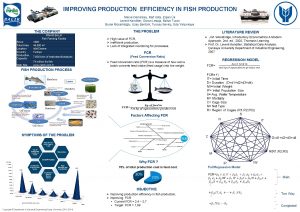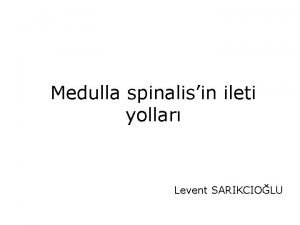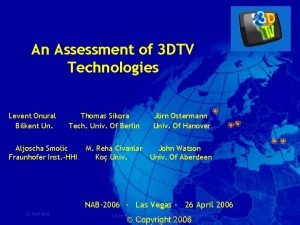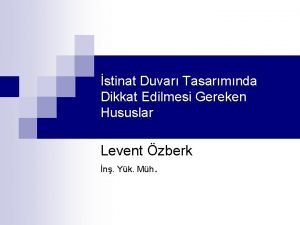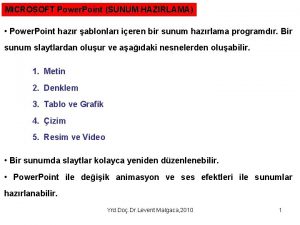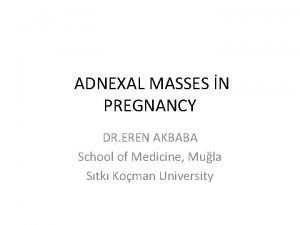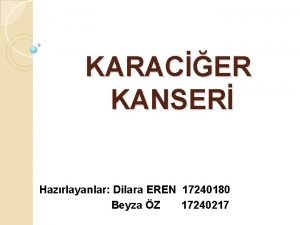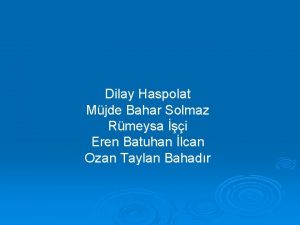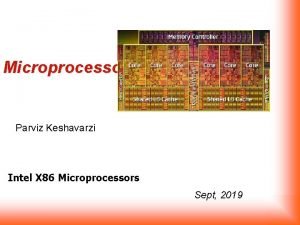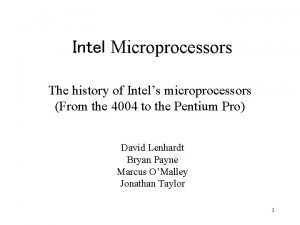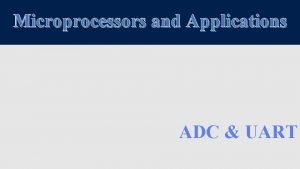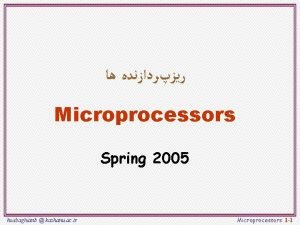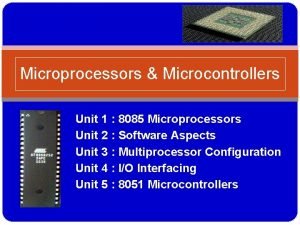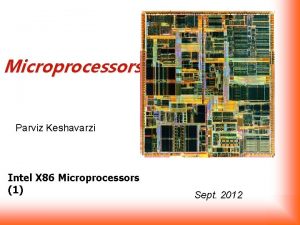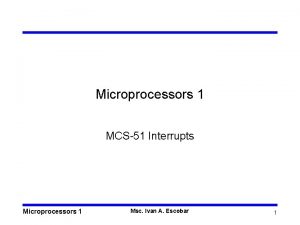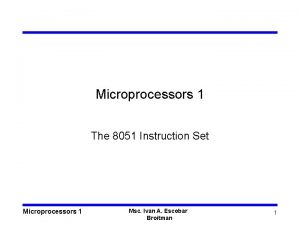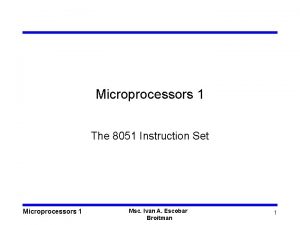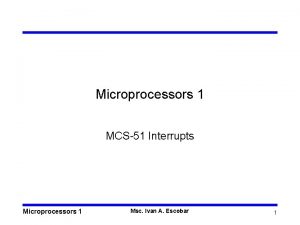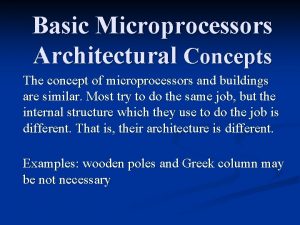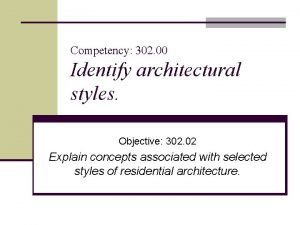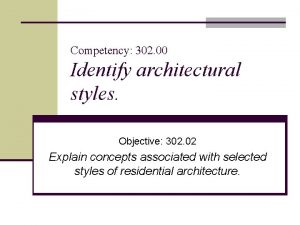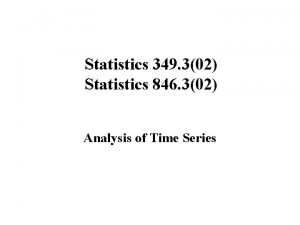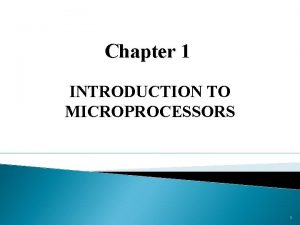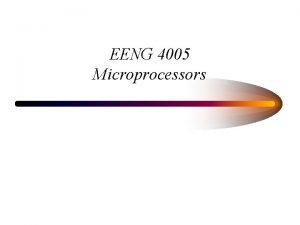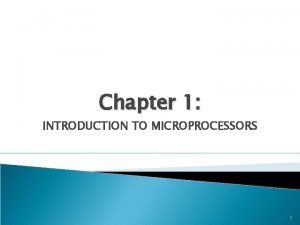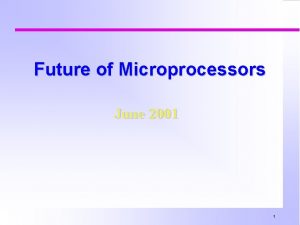CE 302 MICROPROCESSORS LECTURE I Levent Eren Outline



























- Slides: 27

CE 302 MICROPROCESSORS LECTURE I Levent Eren

Outline • • Basic microprocessor and system architecture Memory Programming model Memory addressing – real mode – protected mode • Differences between C and ASM Levent Eren

Microprocessor Architecture Basic Components • CPU Registers – special memory locations constructed from flip-flops and implemented on-chip – e. g. , accumulator, count register, flag register • Arithmetic and Logic Unit (ALU) – ALU is where most of the action takes place inside the CPU • Bus Interface Unit (BIU) – responsible for controlling the address and data busses when accessing main memory and data in the cache • Control Unit and Instruction Set – CPU has a fixed set of instructions with which to work, e. g. , MOV, CMP, JMP, ADD Levent Eren

Microprocessor Architecture Instruction processing • Processing of an instruction by a microprocessor consists of three basic steps (1) fetch instruction from the memory, (2) decode the instruction, and (3) execute (usually involves accessing the memory for getting operands and storing results) • Operation of an early processor, e. g. , 8085 Fetch 1 Busy Levent Eren Decode 1 Idle Execute Fetch 1 2 Busy Decode 2 Idle Execute 2 …. . . Microprocessor Busy …. . . Bus

Microprocessor Architecture Instruction processing • Modern microprocessors can process several instructions simultaneously at various stages of execution – this ability is called pipelining • Operation of the pipelined microprocessor, e. g. , 80486 Fetch 1 Fetch 2 Decode 1 Fetch 3 Fetch 4 Decode 2 Decode 3 Execute 1 Execute 2 3 Generate Address 1 Levent Eren Store 1 Decode 4 Fetch 5 Idle Execute 4 Fetch 6 Read 2 Decode 5 Decode 6 Idle Generate Address 2 Execute 5 Fetch 7 Bus Unit Idle Instruction Unit Execute 6 Execution Unit Address Unit

System Architecture A 19 Address Bus provides a memory address to the system memory and I/O address to the system I/O devices Data Bus transfers data between the microprocessor and the memory and I/O attached to the system Control Bus provides control signals that cause the memory or I/O to perform a read or write operation Levent Eren Address Bus A 0 8086 System Data Bus (16 bit) D 15 D 0 Control Bus RD/WR Memory I/O To memory and I/O

Processor Data and Address Bus Sizes Examples Processor Data Bus Address Bus Max Addressable Memory 8088 8 20 1, 048, 576 (1 Mb) 8086 16 20 1, 048, 576 (1 Mb) 80286 16 24 16, 777, 21 (16 Mb) 80386 dx 32 32 4, 294, 976, 296 (4 Gb) 80486 32 32 4, 294, 976, 296 (4 Gb) 80586/Pentium (Pro) 64 32 4, 294, 976, 296 (4 Gb) Levent Eren

Memory • Microprocessor addresses a maximum of 2 n different memory locations, where n is a number of bits on the address bus • Logical Memory – 80 x 86 supports byte addressable memory – byte (8 bits) is a basic memory unit – e. g. , when you specify address 24 in memory, you get the entire eight bits, nothing less, nothing more – when the microprocessors address a 16 -bit word of memory, two consecutive bytes are accessed Levent Eren

Memory (cont. ) • Physical Memory – The physical memories of 80 x 86 family differ in width • e. g. , 8088 memory is 8 bits wide, • 8086, 80286 memory is 16 bits wide, and • 80386 dx, 80486 memory is 32 bits wide – for programming there is no difference in memory width, because the logical memory is always 8 -bit wide – memory is organized in memory banks • a memory bank is an 8 -bit wide section of the memory • e. g. , the 16 -bit microprocessors contain two memory banks to form a 16 -bit wide section of memory that is addressed as bytes or words Levent Eren

Physical Memory System Example (16 bit microprocessor) High Bank (odd bank) Low Bank (even bank) FFFFFFE FFFFFD FFFFFC FFFFFB FFFFFA 8 bits 000005 000004 000003 000002 000001 000000 D 15 - D 8 Levent Eren D 7 - D 0

Accessing Data in Memory Example (16 bit microprocessor) • Accessing word from an even address - L. O. byte from the address specified and the H. O. byte from the next consecutive address • What if you access a word on an odd address? • Example: access memory on address 125, i. e. , we want to access data on address 125 (L. O. ) and 126 (H. O. ) – this requires two memory operations • read byte on address 125 • read byte on address 126 • swap the positions of these bytes internally since both entered the CPU on the wrong half of the data bus – 80 x 86 CPUs recognize this and perform transfer automatically • Your programs can access words at any address and the CPU will properly access and swap the data in memory • Think about the speed of your program when accessing words at odd addresses Levent Eren

Memory Data Types • Numbers – – – bit (e. g. : 1) ; nibble = 4 bits DB: byte = octet = 8 bits DW: Word = 2 bytes = 16 bits (80 x 86 terminology) DD: Double. Word = 4 bytes = 32 bits (80 x 86 terminology) Intel uses little Indian format (i. e. , LSB at lower address) Signed Integers (2's complement) • Text – – Levent Eren Letters and characters (7 -bit ASCII standard), e. g. , 'A'=65=0 x 41 Extended ASCII (8 -bit) allows for extra 128 graphics/symbols) Collection of characters = Strings Collection of Strings = Documents

Memory Data Types (cont. ) • Programs – Commands (MOV, JMP, AND, OR, NOT) – Collections of commands = subroutines – Collection of subroutines = programs • • Floating point numbers (covered later) Images (GIF, TIF, JPG, BMP) Video (MPEG, Quick. Time, AVI) Audio (voice, music) Levent Eren

Example of Memory with Stored Data Levent Eren Address 0 x. FFFFF. . . 0 x 75000. . . 0 x 70009 0 x 70008 0 x 70007 0 x 70006 0 x 70004 0 x 70003 0 x 70002. . . 0 x 60511 0 x 60510 0 x 6050 F 0 x 6050 E 0 x 6050 D 0 x 6050 C. . . 0 x 55504 0 x 55003 0 x 55002 0 x 55001. . . 0 x 00000 Data (8 -bits) Interpretation 0 x 55 byte '$’ '1' ‘ 9’ ‘ 2’ ‘E’ ‘C’ ‘E’ String 0 x 12 0 x 34 Word 0 x. FE opcode 0 x 02 opcode JE-2 Word 3 x 1 integer array of 16 -bit words Word ADD AL, 2 Program

Programming Model Registers Note: 32 bit registers are not available on 8086, 8088, 80286 Levent Eren

Programming Model Registers (examples) • General-Purpose Registers – AX(accumulator) often holds the temporary result after an arithmetic and logic operation – BX (base) often holds the base (offset) address of data located in the memory • Pointer and Index Registers – SP (stack pointer) used to address data in a LIFO (last-in, first-out) stack memory – BP (base pointer) often used to address an array of data in the stack memory Levent Eren

Programming Model Flag Register • Flags indicate the condition of the microprocessor as well as its operation • The flag bits change after many arithmetic and logic instructions execute • Example flags, – C(carry) indicates carry after addition or a borrow after subtraction – O(overflow) is a condition that occurs when signed numbers are added or subtracted – Z(zero) indicates that the result of an arithmetic or logic operation is zero – T(trap) when the trap flag is set , it enables trapping through the onchip debugging feature Levent Eren

Programming Model Segment Registers • Segment registers generate memory addresses along with other registers in the microprocessor • CS(code) defines the starting address of the section of memoryholding code(programs and procedures used by programs) • DS(data) a section of memory that contains most data used by a program • ES(extra) an additional data segment • SS(stack) defines the area of memory used for the stack • FS and GS available on 80386 and 80486 allow two additional memory segments for access by programs Levent Eren

Real Mode Memory Addressing • 80286 - 80486 microprocessors operate in either the real or protected mode • 8086, 8088, and 80186 only operate in the real mode • Real mode operation allows the microprocessor to only address the first 1 M byte of memory space (even if it is an 80486 microprocessor) • Each of 80 x 86 processors operates in the real mode by default • All real mode memory addresses consist of a segment address plus an offset address – the segment address (in one of the segment registers) defines the beginning address of any 64 K byte memory segment – the offset address selects a location within the 64 K byte memory segment Levent Eren

Real Mode Memory Addressing (cont. ) • Generation of 20 -bit linear address from a segment: offset address • in the real mode, each segment register (16 bits) is internally appended with a 0 h on its rightmost end (i. e. , the segment is shifted left by 4 bits) • The segment and the offset are then added to form 20 -bit memory address. Levent Eren

Real Mode Memory Addressing Examples • (1) Linear address for Segment: Offset = 2222: 3333 = 25553 Segment: offset address for Linear address=25553: • • Many Answers - One possibility: 2222: 3333 Many Answers - One possibility: 2000: 5553 • (2) Linear address for Segment: Offset = 1200: F 445 = 21445 Segment: offset address for Linear address=21445: • • Levent Eren Many Answers - One possibility: 1200: F 445 Many Answers - One possibility 2000: 1445

Protected Mode Memory Addressing • In 80286 and later processors the addressing capabilities of a microprocessor are extended by changing the function the CPU uses to convert a logical address to the linear address space – the protected mode processors use a look up table to compute the physical address – the segment value is used as an index into an array (segment descriptor table) – the contents of the selected array element provides the starting address for the segment – the CPU adds this value to the offset to obtain the physical address Levent Eren

Use of Segments Levent Eren

Peripherals • Memory-mapped devices (special memory locations in the normal address space of the CPU) – BIOS: 0 x. F 0000 -0 x. FFFFF (bootstrap, I/O calls) – Video: 0 x. A 0000 -0 x. BFFFF and v. BIOS: 0 x. C 0000 -0 x. C 7 FFF • I/O mapped devices (sound card, com ports, parallel port) – I/O addresses different than Memory addresses – Address Range: 0 x 0000 - 0 x. FFFF (16 -bit) • Interrupts – Notifies the CPU when an event has occurred • Timer [update clock] , serial I/O [input data], Parallel I/O [ready] • Network adapter [packet arrived] Levent Eren

C versus ASM x 86 assembly C Null EQU 0 #define null 0 myseg SEGMENT PUBLIC myvar 2 DW 017 fh DW ? int myvar = 0 x 017 f, myvar 2; Start() { start: mov ax, cs mov ds, ax mov si, myvar mov myvar 2, null call dosxit END start myseg ENDS Levent Eren _SI=myvar 2 = null; dosxit(); }

Hints for MP 0 Basic Instructions Operation (example) Function MOV AX, CSEG Move contents of Code segment register to the AX register. MOV DX, constant Load the register DX with a fixed value. INC AX Increment register AX. CALL procedure Call a procedure. A return address will go on the stack. CMP AL, constant Compare the register AL with a constant. Set Flags JE label If flags indicate that previous compare was equal, jump to the address of the address defined by label. Levent Eren

Hints for MP 0 Program Directives C ASM Description #define EQU Compile-time substitutions. main Where the program begins. #include extrn: Define external routine. int x = 0 x 5 x db 05 h Allocate memory for a variable and initialize it with a value. Levent Eren
 Levent eren
Levent eren Eren outline
Eren outline Asr instruction in arm
Asr instruction in arm Early microprocessors
Early microprocessors Difference between i c $ microprocessors
Difference between i c $ microprocessors Feature of micro computer
Feature of micro computer 01:640:244 lecture notes - lecture 15: plat, idah, farad
01:640:244 lecture notes - lecture 15: plat, idah, farad Dr levent orlu
Dr levent orlu Adnan levent yaldıran
Adnan levent yaldıran Bilkent sinema televizyon
Bilkent sinema televizyon Dr levent alpay
Dr levent alpay Merve demiralay
Merve demiralay Fasciculus septomarginalis
Fasciculus septomarginalis Levent onural
Levent onural Betonarme
Betonarme Nuc salivatorius inferior
Nuc salivatorius inferior Levent ünsaldı
Levent ünsaldı Levent orlu
Levent orlu Levent aydinoglu
Levent aydinoglu Levent malgaca
Levent malgaca Nip eren
Nip eren Eren kocatürk oyuncu
Eren kocatürk oyuncu Dr eren akbaba
Dr eren akbaba Kanser evreleri
Kanser evreleri Dilay eren
Dilay eren Eren akbaba
Eren akbaba Eren yasger
Eren yasger Prof dr eren gözke
Prof dr eren gözke
